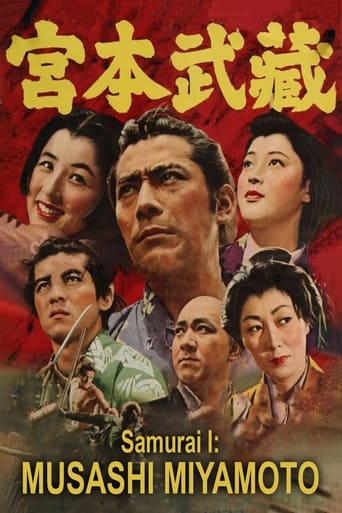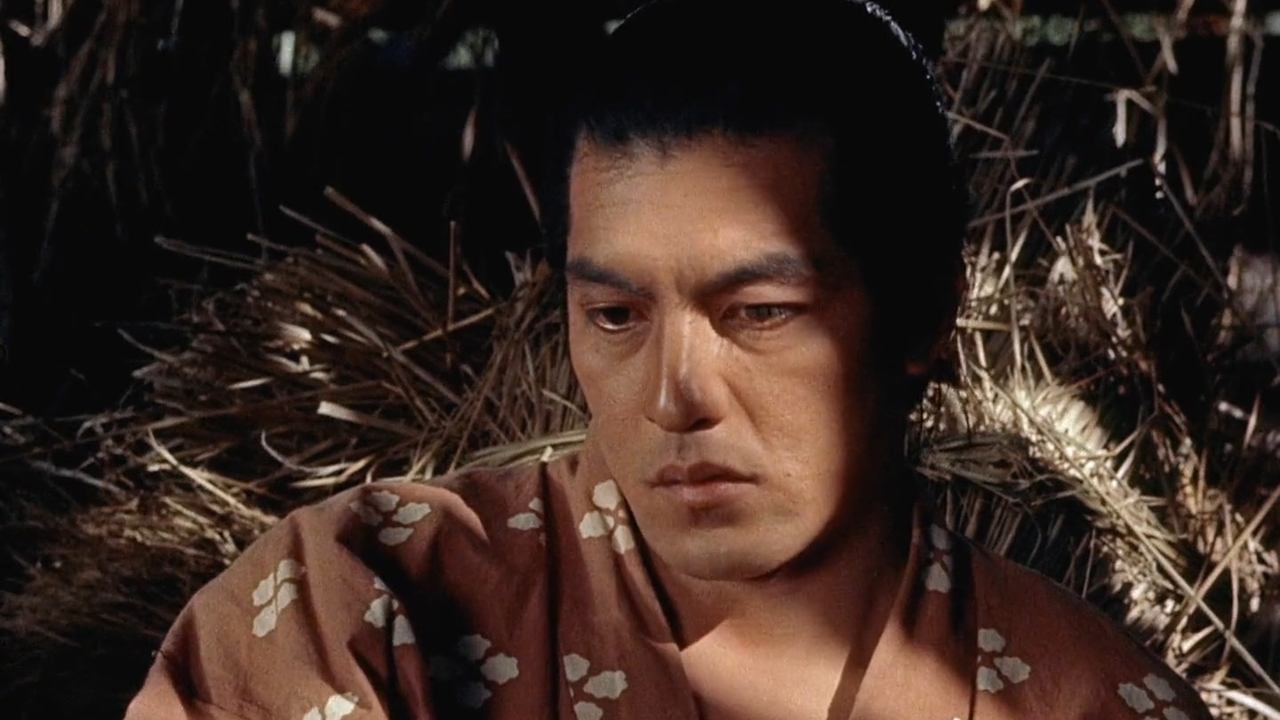chaos-rampant
The story is only beginning in this first film in the Musashi Miyamoto trilogy. Many different conflicts are foreshadowed, this is along classic giri-ninjo lines typical in Japanese jidaigeki, duty versus feeling. Parallel selves being set up, the payoff perhaps for later—two loving girls, two manipulating mothers, resolute Musashi and the contrast in his weak- willed village friend. It roughly begins from the Battle of Sekigahara.So there is not much yet to say, the film is more like the opening act of an epic film than something you may evaluate of itself, it ends just as Musashi embarks on his journey of swordsmanship. Seeing just this, you're left with an open-ended sketch, groundwork. What sketch though! This first film does not show that it mines in a cinematic way Musashi's own rich ideas about the 'Way', but that may be because he is not yet really 'Musashi'. I hope to find more in tandem in futureinstalments.But for now?It's well worth seeing, imagine a classic Hollywood western but instead of Monument Valley, a compendium of sorts of Japanese visual poetry in lush Eastmancolor. Waterfalls, bridges, cherry- blossomed branches against majestic pagodas—all of them emblematic of medieval Japan. Romantic and painterly, as samurai of the time regarded their art of bushido. (though seldom adhered to it)---I plan to watch and write about all three films, lacing each comment with a few notes on the overall context. Some historic groundwork here. The Battle of Sekigahara signalled the end of a long warring period and the beginning of the last Japanese shogunate. Whether or not postwar Japanese audiences consciously identified with the situation, Sekigahara followed the failed attempt to create an Empire over Korea and Ming China, the next such attempt would be undertaken in the 1900's starting with another annexation of Korea and cover much of the same ground as originally coveted, including Manchuria. So the timeline covered in the three films is in essence a postwar period.The outcome of the battle was largely decided by loss of the war and a depletion of troops in Western Japan over the Korean campaign. At Sekigahara, Musashi fought on the losing Western side. Contrary to what is shown in the film, he was a teenager at the time and had already fought duels. It was the leader of the losing Toyotomi fraction that had a few years prior solidified the samurai as a heritable caste.It was at around this time that Rikyu perfects practiced asymmetry in the tea ceremony—Rikyu was tea master of the Toyotomis, eventually forced into seppuku in the years leading to Sekigahara. The ensuing Edo period would more broadly see, forged in relative seclusion, the crystallization of a Japanese identity of which Musashi is among its most emblematic figures. During this time, we have the consolidation of many practices—previously introduced from China—from the tea ceremony to calligraphy and landscape painting, frequently used as diversions by the samurai. Musashi incorporated many in his own practice.So what you see in the film is visually this amalgamation of identity, wonderfully so. It isn't refined beyond appearances, neither were the samurai. This is mingled with a lot of western stuff starting with the score, a rousing piece that reminded me of Morricone.A core principle of this identity is of course bushido, the 'way of the warrior'. It would be exploited in time in the second run for an Empire, with disastrous consequences. However, unlike most warrior lore of the time that simple-mindedly exalted a devoted death, Musashi wrote about more layered stuff. Referred to as strategy in his Book of Five Rings, it is much more, cinematic for our purposes. But more on that later.
futures-1
"Miyamoto Musashi" (1955): by Hiroshi Inagaki, starring Torshiro Mifune. This is an EPIC story of one man who sets out to travel far and wide throughout the land and himself in search of his identity and purpose. It has something of the feel of Herman Hesse's book "Siddhartha", but with Samurai battle scenes
(no, it is NOT a silly martial arts film). Having won the Academy Award for Best Foreign Film of 1955, this is 97 minutes of serious life dramas, with the priorities being Japanese, of course. One must think that with less than a decade having passed since Japan's defeat in WWII, this film's considerations (set in the 16th century) - about identity, goals, love, war, status, and true purpose - were nearly unavoidable. Beautiful photography, good color (considering the era), music that occasionally over-swelled the scene, believable sets, and again, a serious story line, make this one worth seeing. This will sound odd, but I found lots of parallels to the early Marlon Brando film, "The Wild One'". Feel free to disagree.
MisterWhiplash
I watched the first part of the Musashi Miyamoto trilogy, dubbed simply Samurai 1 on the video, thinking that it might be a lot more stylish &/or violent than I was led to believe. It is the first part, but of the second part it is but only up to a point. This is a 1950s style epic tale through and through, and the violence is done in a kind of sweepingly done style, where it goes by fairly quick, no blood at all, though all the while there's the sense of loss that goes with seeing, for example, the big battle sequence early on. This is a trilogy that I saw long ago, but this one, along with some scenes from 2 and 3, sticks out in my mind to this day. There's a lot of touching care taken in what was Hiroshi Inagaki's power as a filmmaker. Like a Hollywood director actually more than a typical Japanese director, one might say, his take on the legendary samurai Miyamoto is one of reverence but wisdom, of production values of the highest standard (of the studio standard of Toho at the time), with brilliant color photography putting the colors in striking displays throughout at a time when Japan was first getting into it. If it's less than really great, like a Kurosawa film, it's maybe because Inagaki is a little too comfortable at times with what's 'safe' in the story, particularly with the romance between Takezo/Musashi (Toshiro Mifune) and Otsu (Kaoru Yachigusa). This actually becomes a little more unbelievable at times in parts 2 and 3, but for the sake of its magisterial, dedicated studio roots, it's not that bad, most notably the final scene at the bridge. Some of the plot on the first viewing may not be completely clear, at least through parts of the middle section involving the betrayals and Takezo's friend Matahachi's relationship with Oko. There are one or two really noteworthy supporting performances, like from Mitsuko Mito as Oko. But it's really Mifune's show here, and he plays Takezo in this film like a more naive but still as ambitious and unruly version of his character in Seven Samurai. He's not altogether, but he has it in him to be more, which of course then leads out into the rest of the trilogy. It's one of his better performances outside of his work with Kurosawa, and it gets better as the films go on.Of course, it's best to start here with Inagaki's passionate, rousing work, and even if it isn't the best of the three it still has its high points. It's a very good example of an 'old-school', big-budget Toho picture with their brand of excitement and romance. If you're thinking it will be as graphic or darkly comic as Kurosawa's films though, it's not really here (though only in little sparks, as is more Inagaki's straghtforward style).
Atavisten
This movie doesn't take much brainpower, but is a fine tale about two friends who leave their village in a quest for glory. Its set in feudal age Japan and the scenery is beautiful! Mountains, green pastures, lakes, forests with bamboo undergrowth and the cities and villages in typical style serves as the backdrop.Takezo (Mifune) is the strong and wild character all the woman likes, but he cant handle the attention very well so he keeps running. All the characters as well as the story is not hard to get, so this is one to bring in the kids on.Will defo check the rest of the series out, maybe the books as well.


 AD
AD




